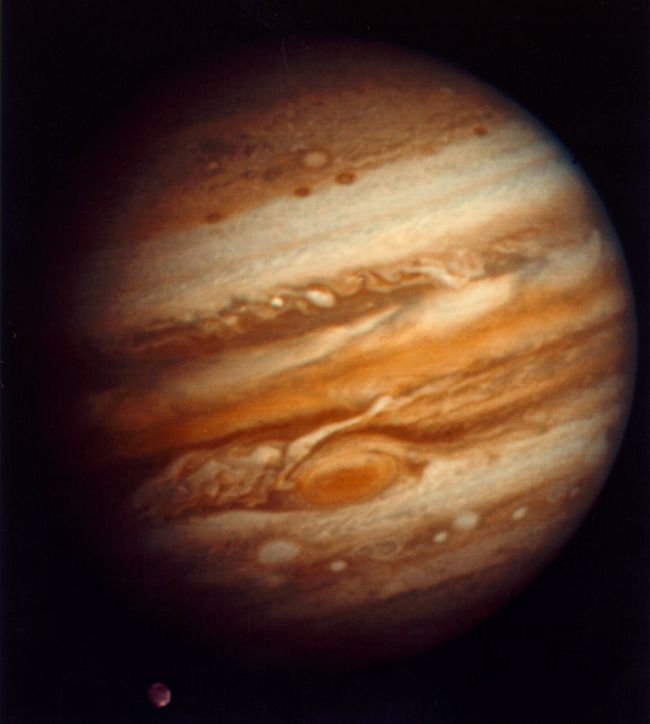Search the Community
Showing results for tags 'space'.
-
@LazyHippo
-

News China's First Mars Spacecraft Undergoing Integration for 2020 Launch
Night Hunter posted a topic in Science & Space
HELSINKI — China remains on schedule to ready its first independent mission to Mars in time for a short launch window in mid-2020, according to a leading space official. "Mars 2020 mission spacecraft is undergoing integration," Wang Chi, director of the National Space Science Center (NSSC) in Beijing, told SpaceNews in a rare update on the mission. Ambitiously, the mission consists of both an orbiter and a rover, with a total of 13 science payloads. The NSSC will be involved in integration of the instruments with the spacecraft. The orbiter will be equipped with a high-resolution camera comparable to HiRise on board NASA's Mars Reconnaissance Orbiter, a medium-resolution camera, subsurface radar, minearology spectrometer, neutral and energetic particle analyzers and a magnetometer. The 240-kilogram solar-powered rover, nearly twice the mass of China's Yutu lunar rovers, will carry a ground-penetrating radar, multispectral camera, a Laser Induced Breakdown Spectroscopy instrument and payloads for detecting the climate and magnetic environment. Meanwhile, the Academy of Aerospace Propulsion Technology, an institute under main space contractor the China Aerospace Science and Technology Corporation (CASC), this month completed testing of a variable thrust engine, capable of 7,500 Newtons of thrust, which will provide the majority of deceleration for the landing. Two preliminary landing areas have been selected. The first is Chryse Planitia, close to the landing sites of NASA's Viking 1 and Pathfinder, with the second covering Isidis Planitia and stretches to the western edge of the Elysium Mons region, between the landing sites of Curiosity and Viking 2. Site selection has been driven by a range of factors including flight system engineering constraints and the challenges of entry, descent and landing (EDL) on the Red Planet, and the science goals of the mission. China has landed two spacecraft, Chang'e-3 and Chang'e-4, on the moon, but the challenges for Mars are greater and more varied. The presence of a thin atmosphere poses dangers to the spacecraft through aerothermal heating but does not provide great assistance for slowing or descending via parachute, while the remoteness of Mars means EDL process will be automated. The spacecraft will employ blunt body aerodynamics, a supersonic parachute and powered descent for its landing attempt. Only NASA has succeeded in successfully landing and operating spacecraft on Mars, while Russia and European Space Agency have failed will multiple attempts. A Long March 5, China's most powerful launch vehicle, is required to launch the mission, though the heavy-lift rocket has not flown since a failure in 2017. A return to flight scheduled for mid-July appears to have slipped, as the rocket components have yet to be slipped to the Wenchang Satellite Launch Center. A successful launch of the Long March 5 will be required for China to be ready for the Mars Hohmann transfer window in 2020, and missing this low-energy launch period would bring a wait of 26 months until the next mission launch opportunity. Also launching missions to Mars during the launch window in July-August 2020 will be NASA, sending a 1,050-kilogram rover to Jezero crater, the ESA-Russia ExoMars 2020 lander and rover, and an orbiter from the United Arab Emirates. India became the first Asian country to succeed with a mission to the Red Planet with the Mars Orbiter Mission spacecraft which entered orbit in 2014. China's own first attempt, the Yinghuo-1 spacecraft which piggybacked on the Russian Phobos-Grunt sample return mission, was lost when its Zenit-2SB rocket failed to leave Earth orbit. China's Chang'e-4 spacecraft on the far side of the moon began a sixth lunar day of activities earlier this week, with the Yutu-2 rover awakening at 2:16 p.m. Eastern May 27, and the lander following at 6 a.m. May 28. The Lunar Exploration and Space Program Center of the China National Space Administration made the announcement May 28, stating that all eight science payloads would continue operation. Despite a decrease in drive distances across lunar days, Wang Chi states that Yutu-2, "keeps roving and making observations as scheduled." Yutu-2 drove just 11.76 meters across day five, having covered 120 meters across the first two lunar days of operations. A Chinese language space popularization blog stated following the end of lunar day five that sunlight reflected from the rover body onto the surface was causing issues with the obstacle detection systems, preventing roving. Early results from the Visible and Near Infrared Spectrometer aboard Yutu-2 reported in Nature this month suggest the in-situ detection of materials originating from the lunar mantle in the regolith of Von Kármán crater. Source https://www.space.com/chinas-first-mars-spacecraft-for-2020-launch.html-
- 1
-

-
WASHINGTON — The governments of the United States and Japan have agreed to further cooperation in space which could include flying Japanese astronauts to the moon. At a joint press conference in Tokyo May 27 with Prime Minister Shinzo Abe, President Donald Trump mentioned cooperation in space exploration as one outcome of their meetings during the president’s visit to the country. "I am pleased to confirm that Prime Minister Abe and I have agreed to dramatically expand our nations’ cooperation in human space exploration," Trump said. "Japan will join our mission to send U.S. astronauts to space. We'll be going to the moon. We'll be going to Mars very soon. It's very exciting." Neither Trump nor Abe elaborated on the nature of that agreement, which was not released. A fact sheet released by the State Department May 27 noted that the two "agreed on the importance of a sustained human presence on and around the moon." "Building on its International Space Station (ISS) experience, Japanese astronauts will strive to join American astronauts on the moon and destinations beyond," the State Department fact sheet noted. A cooperative agreement of some kind between the United States and Japan was expected to be signed during Trump's visit. Japan, a major partner on the ISS, had shown an interest in participating in aspects of NASA's renewed push to return to the moon, including contributing modules to the Gateway facility NASA plans to develop in lunar orbit to support human lunar landings. "It's a great pleasure to collaborate with NASA in that endeavor," Hiroshi Yamakawa, president of the Japanese space agency JAXA, said in a video released by NASA May 28 about international cooperation on the development of the Gateway and its overall lunar plans. In a May 28 tweet, NASA Administrator Jim Bridenstine said he was “very excited” about the agreement announced by Trump and Abe. “Japan and [JAXA] are critical partners in our efforts to go forward to the Moon and on to Mars!” With NASA accelerating its plans to return humans to the lunar surface by 2024, versus the 2028 date in its previous plans, major roles for international partners will mostly be deferred to the second phase, which will focus on establishing a sustainable human presence on and around the moon after the 2024 landing. That would include contributions such as Gateway modules, which could give contributing countries slots on later lander missions in much the same way ISS partners get crew slots on space station missions. "Accelerating the landing date to 2024 makes it harder for us to incorporate our international partners early," acknowledged Ken Bowersox, deputy associate administrator for human exploration and operations at NASA, during a May 28 meeting of a NASA Advisory Council committee. "We're still looking at working with our international partners. A lot of their elements were going to come after 2024 anyway." However, he added that if international partners can accelerate their contributions, "they're welcome to participate in the early phases." It's unclear if this agreement with have any effect on other aspects of U.S.-Japan space activities, government or commercial, but companies welcome the agreement in any event. An example is Japanese company ispace, which is developing commercial lunar landers and is part of a team led by American company Draper that won one of nine Commercial Lunar Payload Services agreements from NASA last November to transport research payloads to the lunar surface. "We are thrilled to learn that the U.S. and Japan will deepen its strong relationship in space exploration through a focused effort on lunar exploration," Takeshi Hakamada, founder and chief executive of ispace, said in a statement to SpaceNews. "Alongside our American partner, Draper, ispace is well prepared and eager to support this new endeavor between the U.S. and Japan." Source https://www.space.com/us-japan-cooperation-moon-return.html
-
it was 40 years ago today (March 5) that Voyager 1 flew past Jupiter, revealing a surprising planetary system that includes moons of ice and fire. And scientists are still looking at some of these moons for signs of habitability for microbes. Voyager 1 and its twin spacecraft, Voyager 2, both left Earth in 1977 on the trail of an unusual planetary alignment that happens every 175 years, according to NASA. The gas giant planets Jupiter, Saturn, Uranus and Neptune lined up in such a way that a spacecraft could use the gravitational field of one planet to swing on to the next. Voyager 1 flew past all four planets, while Voyager 2 instead traveled high above the plane of the solar system after visiting Jupiter and Saturn. Between them, the two spacecraft garnered basic knowledge about these large planets — measuring their atmospheres, their ring systems, their magnetic fields (including Jupiter's especially strong one) and how their inner cores may function. Jupiter had already been visited by the Pioneer spacecraft, but it still held surprises for Voyager 1 when it flew by in 1979. "Jupiter's atmosphere was found to be more active than during the visits of Pioneer 10 and 11, sparking a rethinking of the earlier atmospheric models which could not explain the new features. The spacecraft imaged the moons Amalthea, Io, Europa, Ganymede and Callisto, showing details of their terrain for the first time," NASA officials said in a statement. "Possibly the most stunning of Voyager 1's discoveries was that Io has extremely active volcanoes, powered by heat generated by the stretching and relaxing the moon endures every 42 hours as its elliptical orbit brings it closer to and then farther from Jupiter," NASA officials added. "The spacecraft also discovered a thin ring around the planet (then making it the second planet known to have a ring), and two new moons: Thebe and Metis." Io's volcanic plumes are now being imaged regularly by NASA's Juno spacecraft. And Voyager's discoveries at Europa, Ganymede and Callisto will soon result in a more close-up examination of these bodies. These moons have icy surfaces and probable global oceans underneath, according to joint observations from the Voyager spacecraft, Galileo mission (which orbited Jupiter between 1995 and 2002); and even the Hubble Space Telescope, which spotted periodic spurts of what appears to be water emanating from Europa. Thanks to the intense flexing these moons' interiors receive as they orbit Jupiter, it's possible that the oceans host all the ingredients necessary for life. But scientists need more spacecraft observations to confirm this. NASA is hard at work on the Europa Clipper, which is expected to go into orbit around Europa in the 2030s to see if this icy moon is host to conditions that could support microbial life. The European Space Agency's JUpiter ICy moons Explorer (JUICE) mission will launch from Earth in 2022 to study all three icy moons, but most especially Ganymede. JUICE will study the moons' oceans, ice layers and general geology, as well as learn more about their exospheres (tenuous atmospheres) and magnetic fields. Source https://www.space.com/voyager-1-jupiter-flyby-40-years-ago.html
-
- 1
-

-
- spacenews
- returnofnews
-
(and 1 more)
Tagged with:
-
Our beloved space never stops to amaze us, enjoy watching how tiny we are in front of it
-
This movie is no extraordinary i say, but for the purpose of entertaining i'd say it's a good movie. The first human born on Mars travels to Earth for the first time, experiencing the wonders of the planet through fresh eyes. He embarks on an adventure with a street smart girl to discover how he came to be. Would love to read your opinions for those who already watched it.
-
A powerful solar storm nearly heated the Cold War up catastrophically a half century ago, a new study suggests. The U.S. Air Force began preparing for war on May 23, 1967, thinking that the Soviet Union had jammed a set of American surveillance radars. But military space-weather forecasters intervened in time, telling top officials that a powerful sun eruption was to blame, according to the study. "Had it not been for the fact that we had invested very early on in solar and geomagnetic storm observations and forecasting, the impact [of the storm] likely would have been much greater," Delores Knipp, a space physicist at the University of Colorado Boulder and the study's lead author, said in a statement. "This was a lesson learned in how important it is to be prepared." [The Sun's Wrath: Worst Solar Storms in History] Frightening false alarm The storm began brewing on May 18, 1967, when researchers noticed a big group of sunspots with strong magnetic fields clumped on one part of the solar disk. Sunspots — dark, relatively cool areas on the sun's surface — serve as launching pads for powerful bursts of high-energy radiation known as solar flares, as well as eruptions of solar plasma called coronal mass ejections (CMEs), which almost always accompany strong flares. Intense flares that hit Earth can disrupt radio transmissions and satellite communications, among other effects. Earth-directed CMEs can be even more damaging; big ones can spawn "geomagnetic storms" that blow out transformers in power grids, for example. On May 23, 1967, the sun fired off a flare so powerful that it was visible to the naked eye, and began emitting radio waves at a level that had never been seen before, study team members said. That same day, all three of the Air Force's Ballistic Missile Early Warning System radar sites in the far Northern Hemisphere — which were located in Alaska, Greenland and the United Kingdom — appeared to be jammed. Air Force officials initially assumed that the Soviet Union was responsible. Such radar jamming is considered an act of war, so commanders quickly began preparing nuclear-weapon-equipped aircraft for launch. (These newly scrambled aircraft would have been "additional forces," according to the study authors; the U.S. kept nuke-bearing "alert" planes aloft pretty much continuously throughout the 1960s.) "This is a grave situation," Knipp said. "But here's where the story turns: Things were going horribly wrong, and then something goes commendably right." Those additional forces never launched. So what happened? Solar forecasters at the North American Aerospace Defense Command (NORAD) — a joint U.S.-Canadian effort that looks out for incoming missiles and other possible threats — and elsewhere figured out that the flare, not the Soviets, had disrupted the radars. (The U.S. military had begun keeping tabs on solar activity, and its effects on Earth, in the 1950s; by 1967, NORAD was getting daily updates on the subject, study team members said.) Knipp and her colleagues think this information made it in time to Air Force commanders and other high-ranking officials — including, perhaps, President Lyndon Johnson. "Oftentimes, the way things work is, something catastrophic happens, and then we say, 'We should do something so it doesn't happen again,'" Morris Cohen, an electrical engineer and radio scientist at the Georgia Institute of Technology in Atlanta, said in the same statement. "But in this case, there was just enough preparation done just in time to avert a disastrous result," added Cohen, who was not involved in the new study. A solar superstorm The flare on May 23, 1967, was accompanied by a CME, which hit Earth about 40 hours later. (CMEs travel through space at millions of miles per hour — fast, but not nearly as fast as solar-flare radiation, which, of course, moves at the speed of light.) The CME triggered a powerful geomagnetic storm, which disrupted American radio communications for nearly a week, study team members said. This storm also ramped up the northern lights, making them visible as far south as New Mexico. "As a magnetospheric disturbance, the 25-26 May event ranks near the top in the record books," Knipp and her colleagues wrote in the new study, which has been accepted for publication in the journal Space Weather. You can read a copy of the paper for free here. The top spot in the record books, incidentally, likely belongs to the famous Carrington Event of September 1859. That geomagnetic storm caused telegraph systems to fail all over North America and Europe, and the northern lights were visible as far south as the Caribbean. A Carrington-like storm today would likely be devastating, given how much more dependent the world is on technological infrastructure such as power grids and satellite networks, experts have said. Source http://www.space.com/33687-solar-storm-cold-war-false-alarm.html
-
- 1
-

-
By pushing the NASA/ESA Hubble Space Telescope to its limits astronomers have shattered the cosmic distance record by measuring the distance to the most remote galaxy ever seen in the Universe. This galaxy existed just 400 million years after the Big Bang and provides new insights into the first generation of galaxies. This is the first time that the distance of an object so far away has been measured from its spectrum, which makes the measurement extremely reliable. The results will be published in the Astrophysical Journal. Using the NASA/ESA Hubble Space Telescope an international team of astronomers has measured the distance to this new galaxy, named GN-z11. Although extremely faint, the galaxy is unusually bright considering its distance from Earth. The distance measurement of GN-z11 provides additional strong evidence that other unusually bright galaxies found in earlier Hubble images are really at extraordinary distances, showing that we are closing in on the first galaxies that formed in the Universe. Previously, astronomers had estimated GN-z11's distance by analysing its colour in images taken with both Hubble and the NASA Spitzer Space Telescope. Now, for the first time for a galaxy at such an extreme distance, the team has used Hubble's Wide Field Camera 3(WFC3) to precisely measure the distance to GN-z11 spectroscopically by splitting the light into its component colours. "Our spectroscopic observations reveal the galaxy to be even further away than we had originally thought, right at the distance limit of what Hubble can observe," explains Gabriel Brammer of the Space Telescope Science Institute and second author of the study. This puts GN-z11 at a distance that was once thought only to be reachable with the upcoming NASA/ESA/CSA James Webb Space Telescope (JWST). "We've taken a major step back in time, beyond what we'd ever expected to be able to do with Hubble. We managed to look back in time to measure the distance to a galaxy when the Universe was only three percent of its current age," says Pascal Oesch of Yale University and lead author of the paper. To determine large distances, like the one to GN-z11, astronomers measure the redshift of the observed object. This phenomenon is a result of the expansion of the Universe; every distant object in the Universe appears to be receding from us and as a result its light is stretched to longer, redder wavelengths. Before astronomers determined the distance to GN-z11, the most distant measured galaxy, EGSY8p7, had a redshift of 8.68. Now, the team has confirmed GN-z11's distance to be at a redshift of 11.1, which corresponds to 400 million years after the Big Bang. "The previous record-holder was seen in the middle of the epoch when starlight from primordial galaxies was beginning to heat and lift a fog of cold, hydrogen gas," explains co-author Rychard Bouwens from the University of Leiden, the Netherlands. "This transitional period is known as the reionisation era. GN-z11 is observed 150 million years earlier, near the very beginning of this transition in the evolution of the Universe." The combination of observations taken by Hubble and Spitzer revealed that the infant galaxy is 25 times smaller than the Milky Way and has just one percent of our galaxy's mass in stars. However, the number of stars in the newborn GN-z11 is growing fast: The galaxy is forming stars at a rate about 20 times greater than the Milky Way does today. This high star formation rate makes the remote galaxy bright enough for Hubble to see and to perform detailed observations. However, the discovery also raises many new questions as the existence of such a bright and large galaxy is not predicted by theory. "It's amazing that a galaxy so massive existed only 200 million to 300 million years after the very first stars started to form. It takes really fast growth, producing stars at a huge rate, to have formed a galaxy that is a billion solar masses so soon," explains Garth Illingworth of the University of California, Santa Cruz. Marijn Franx, a member of the team from the University of Leiden highlights: "The discovery of GN-z11 was a great surprise to us, as our earlier work had suggested that such bright galaxies should not exist so early in the Universe." His colleague Ivo Labbe adds: "The discovery of GN-z11 showed us that our knowledge about the early Universe is still very restricted. How GN-z11 was created remains somewhat of a mystery for now. Probably we are seeing the first generations of stars forming around black holes?" These findings provide a tantalising preview of the observations that the James Webb Space Telescope will perform. "This new discovery shows that JWST will surely find many such young galaxies reaching back to when the first galaxies were forming," concludes Illingworth. Source http://phys.org/news/2016-03-hubble-cosmic-distance.html
-
- 1
-

-
Found this to be a neat read February 4, 1906 – January 17, 1997. Today is the 110th birthday of American astronomer Clyde W. Tombaugh, who discovered the planet Pluto. Tombaugh grew up on a farm in Streator, Illinois. It’s said that, after his family’s crops were destroyed by a hailstorm, he gave up the possibility of attending college, but never gave up his dream of becoming an astronomer. By himself, he learned mathematical skills required for astronomy, including geometry and trigonometry. He later said: Can you imagine young people nowadays making a study of trigonometry for the fun of it? Well I did. More: http://earthsky.org/space/this-date-in-science-clyde-tombaugh-discoverer-of-pluto
-
You can say what you like about our nearest star, but as this latest solar eruption proves, it certainly has impeccable timing. On Monday (Dec. 28), a sunspot cluster erupted, blasting an M-class flare directly at Earth. The extreme-ultraviolet radiation immediately washed over our upper atmosphere, initiating an ionization event that caused a radio blackout over South America, Africa and the south Atlantic Ocean. The blackout may have been detected by mariners and ham radio operators in the 20MHz frequency range, according to SpaceWeather.com Although the flare certainly wasn’t of the strength of a major X-class flare (the most powerful class of flare), this event did trigger a significant coronal mass ejection (CME) that is currently racing in the direction of Earth. Space weather forecasters predict a direct hit with Earth’s magnetic field on or around New Year’s Eve, potentially sparking some natural fireworks in the upper atmosphere just in time for 2016. “Sunspot AR2374 has an unstable ‘beta-gamma’ magnetic field that could explode again in the hours ahead,” writes NASA’s Tony Phillips for SpaceWeather.com. “NOAA forecasters estimate a 55 percent chance of additional M-class flares and a 10 percent chance of X-flares on Dec. 28th.” Flares and CMEs are different beasts triggered by the same magnetic phenomenon. During periods of high magnetic activity on the sun, the sun’s internal magnetic field forces its way through the sun’s photosphere (colloquially known as the sun’s “surface”). This magnetism exposes the inner sun, which is counter-intuitively cooler (and therefore appears darker) than the sun’s chromosphere (the layer of atmosphere above the photosphere) and corona (the sun’s extended and multi-million degree atmosphere). Therefore, magnetically active regions can be easily seen on the sun’s disk as spots and clusters of dark spots known as “sunspots.” As the magnetic field lines become forced together above these sunspots, magnetic reconnection may occur, accelerating solar plasma to relativistic speeds, generating intense bursts of radiation. These are solar flares and their radiation reaches Earth in minutes. However, CME’s are bubbles of magnetized high-energy plasma that are ejected into space at high speed, but nowhere near relativistic speeds. CMEs can reach Earth in several hours or a few days, depending on the ferocity of the eruption. And today’s flare and CME happened to be generated by the same sunspot that was Earth-directed, maximizing our chances of having a geomagnetic storm right in time for New Year’s. So if you live in high latitudes, and pay attention to the sky, you may be in for a New Year treat as high-energy solar particles impact our atmospheric gases, generating bright aurora. Source http://www.space.com/31484-sun-blasts-flare-at-earth-new-year-s-eve-storm.html
-
Artist's illustration of the Giant Magellan Telescope (GMT), which will be built atop Las Campanas Peak in Chile. The groundbreaking ceremony for GMT, which will feature seven mirrors arranged to form a light-collecting surface 80 feet (24 meters) wide, is scheduled for Nov. 11, 2015. Credit: Giant Magellan Telescope - GMTO Corporation Construction will begin this week on a giant new telescope in the mountains of Chile, and Space.com will be there to take in the milestone moment. The groundbreaking ceremony for the Giant Magellan Telescope (GMT) — a huge instrument that astronomers will use to hunt for signs of life in the atmospheres of alien planets, probe the nature of dark energy and dark matter, and tackle other big cosmic questions — is scheduled to occur Wednesday (Nov. 11) at the Las Campanas Observatory in the Chilean Andes. When it's finished, the GMT will consist of seven 27.6-foot-wide (8.4 meters) primary mirrors — the largest single-piece astronomical mirrors ever made — arranged into one light-collecting surface 80 feet (24 m) across, as well as seven smaller secondary mirrors that will change shape to counteract the blurring effects of Earth's atmosphere. The finished observatory will boast about 10 times the resolving power of NASA's famous Hubble Space Telescope, GMT officials have said. Four of the 20-ton primary mirrors have already been cast, at the University of Arizona's Steward Observatory Mirror Lab. All four should be fully polished (a time-consuming, exacting task) and delivered to Las Campanas by late 2021, allowing the telescope to begin science operations around that time, said GMT director Pat McCarthy. "That will give us the world's largest telescope by more than a factor of two at that point," McCarthy told Space.com in September, shortly after the casting of the fourth mirror had been completed. Primary mirrors number five, six and seven will probably be installed at the rate of about one per year after that, bringing the GMT up to full strength around 2024 or so, he added. Two other megascopes should also be coming online at about that time — the Thirty Meter Telescope (TMT) in Hawaii and the European Extremely Large Telescope (E-ELT), which, like GMT, will view the heavens from the Chilean Andes. TMT and E-ELT will combine hundreds of relatively small mirrors to form light-collecting surfaces that measure 98 feet (30 m) and 128 feet (39 m) wide, respectively. These three enormous ground-based observatories — along with NASA's James Webb Space Telescope, which is scheduled to launch in late 2018 — should usher in a sort of astronomy golden age, McCarthy said. "About seven to 10 years from now, there will be observational capabilities that are completely unprecedented," he said. "I expect we will make a big leap in our understanding [of the cosmos], but I also suspect that we'll find out that some of the things that we believe now turn out not to be quite correct. Often in science, the more you learn, the more you realize that there's a lot to learn." Source http://www.space.com/31060-giant-magellan-telescope-chile-groundbreaking-soon.html
-
Astronomers working with the Atacama Large Millimeter/submillimeter Array (ALMA) have discovered what they claim could be another large planet on the fringes of our solar system. While examining the Alpha Centauri star system, the nearest to Earth, they noticed a fast-moving object crossing their field of view. Its speed and brightness allowed them to rule out another star as the culprit, and based on wavelength readings obtained from ALMA, they believe it could be a Trans-Neptunian Object (TNO) orbiting the sun somewhere between 10 billion and 2 trillion miles from our home star. For comparison, Pluto is less than 4 billion miles away from the sun. Although the finding is intriguing, the news has been met with a healthy dose of skepticism. A New Member of the Solar System? Stars typically emit too much light for astronomers to discern any objects in their immediate vicinity, but the ALMA observatory was built to capture low-frequency wavelengths, allowing researchers to see objects that are closer to stars. This is how researchers noticed a mysterious object moving relative to Alpha Centauri, exhibiting what scientists call “proper motion.” The researchers suggest the object could be one of several celestial bodies, including a brown dwarf, a super-Earth (a planet larger than Earth but smaller than Neptune), or a much smaller, icy body orbiting beyond Pluto. Researchers posted their findings online Thursday to arXiv, but they are still awaiting peer review. Hold Your Horses While the possibility of adding another large planet to our solar neighborhood is exciting, the likelihood that this object, if it exists, is a so-called “super- Earth,” is probably quite small. The ALMA observatory can only look at a tiny fraction of the sky at any given moment. For their study, the researchers could only observe, at maximum, one arcminute, or 1/21,600th, of the heavens. To put that in perspective, the moon is 30 arcminutes across when full and viewed from Earth. Therefore, the odds that researchers happened to catch a large planet in their narrow gaze are pretty small. As Caltech astronomer Mike Brown pointed out via Twitter, "Fun fact: if it is true that ALMA accidentally discovered a massive outer solar system object in its tiny tiny tiny field of view, ... that would suggest that there are something like 200,000 earth sized planets in the outer solar system. Which, um, no." The far more likely possibility is that the astronomers captured one of the many icy objects floating beyond Pluto in the Kuiper Belt and the far-flung Oort Cloud. There are millions of such objects, ranging in size from less than a mile in diameter to almost 1,500 miles. And, as Bad Astronomy’s Phil Plait pointed out, the WISE observatory performed a comprehensive scan of the sky last year, and found no large planets beyond Pluto. WISE senses infrared radiation, which makes warm objects appear bright, so the absence of any WISE data means that the most probable identity of this newfound object in our solar system is a small, cold body orbiting far beyond Pluto. While this doesn’t entirely discount the presence of a super-Earth, it makes the probability very small —too small, perhaps, for us to warrant getting our hopes up too high. For now, we’ll just have to hold our breath and wait for these results to get vetted. Source http://www.astronomy.com/news/2015/12/a-new-planet-in-the-outer-solar-system-not-so-fast
-
The NASA/ESA Hubble Space Telescope captured this striking image of the galaxy NGC 7049, with its dust lanes backlit by the stars in its central halo. Credit: NASA/ESA/W. Harris A previously unidentified highway of dust extends across the Milky Way, between the sun and the central bulge of the galaxy, scientists have found. Called the "Great Dark Lane" by the astronomers who announced it, the dusty road twists in front of the bulge of the galaxy. "For the first time, we could map this dust lane at large scales, because our new infrared maps cover the whole central region of the Milky Way," Dante Minniti, a researcher at Universidad Andres Bello in Chile and lead author of a study describing the findings, told Space.com by email. Mapping the Milky Way The center of a spiral galaxy contains a collection of stars that bulge above and below the flatter spirals, much like an egg yolk. The arms that give the galaxies their classification twist around the bulge, often in a beautiful spiral (although sometimes they are more elongated). Lanes of dust often lie between these arms, which present a particular challenge to map out. [stunning Photos of Our Milky Way Galaxy (Gallery)] "It is very difficult to mapthe structure of our galaxy because we are inside, and it is very large and covered with dust clouds that are opaque in the optical," Minniti said. Images like this one from the VVV survey helped lead author Dante Minniti identify the Milky Way's great dark lane. Credit: ESO/VVV Survey/D. Minniti, I. Toledo Working with a team of astronomers, Minniti used the European Space Observatory's Vista Variables in the Via Lactea Survey (VVV), a project to scan the Milky Way using the VISTA telescope in Chile, to study the galaxy in the near-infrared. At this wavelength, telescopes are able to peer through the clouds of dust to a group of objects known as red clump (RC) stars lying within the bulge. Red clump stars have helium-burning cores that generate a similar brightness no matter what their age or composition is. This makes them reliable distance indicators for astronomers. Based on the measurement of 157 million stars, Minniti and his team found that the RC stars of the Milky Way's bulgewere split into two colors — a difference they determined was caused by dust between the stars and the observers. The astronomers could see a sharp transition between the two distinct groups — the dusty Great Dark Lane dividing them. The Great Dark Lane extends approximately 20 degrees across the sky, reaching both above and below the plane of the galaxy. It sits roughly 15,000 light-yearsfrom the solar system, although the team is still working to refine the distance. It lies outside of the bulge rather than being contained within it, they said. If the dust passed through the bulge itself, the red clump stars of the center would have a patchier distribution, rather than a clean break, as some of the stars at a certain height above the plane would be in front of the dust and others would be behind it, the researchers said. Instead, all of the red clump stars contained within the bulge lie behind the dust, according to the study. "Detailed maps and modeling are needed in order to test this important galactic feature," the researchers wrote in their paper, which appeared in the journal Astronomy & Astrophysics last year. http://www.space.com/31046-milky-way-has-great-dark-lane.html
-
New satellite images from NASA have revealed unusual, massive patterns on the Earth’s surface. The geometric shapes are located in Kazakhstan, and are estimated to be up to 8,000 years old. The massive earthwork patterns called the Steppe Geoglyphs were originally discovered by a Kazakh economist when he was browsing Google Earth in 2007. When browsing through an otherwise empty Central Asian landscape, Dimitriy Dey found intriguing markings in the soil. But the study of these mysterious constructs is ramping up, and even NASA has taken an interest. Two weeks ago, the space agency released clear satellite photographs of the figures from about 430 miles in the sky. “I’ve never seen anything like this; I found it remarkable,” Compton J. Tucker, a senior biospheric scientist for NASA who provided the archived images, told The New York Times. The images show colossal squares, crosses, swastikas and rings, some of which reach over a kilometer in length. The oldest of these geometric shapes are estimated to have been made 8,000 years ago – over three millenniums older than the Egyptian pyramids. The patterns are formed from uniformly circular mounds of dirt three feet high and thirty feet wide. There are at least 260 of the mounds, and they we described last year at archaeology in Istanbul as a previously unstudied phenomenon. Dey’s research suggests that the figures could have been constructed by the Mahandzhar culture, who thrived in the vast steppes of what is now northern Kazakhstan between 5,000 and 7,000 B.C. This is an unusual development, since experts otherwise wouldn’t expect that a nomadic population would stay in place for the significant time and effort required to make the huge mounds. Indeed, University of Winnipeg archaeologist Persis B. Clarkson says that constructions like these and the similar Nazca lines in Peru are challenging prevailing views of early people and nomads. “The idea that foragers could amass the numbers of people necessary to undertake large-scale projects – like creating the Kazakhstan geoglyphs – has caused archaeologists to deeply rethink the nature and timing of sophisticated large-scale human organization as one that predates settled and civilized societies,” Dr. Clarkson said, according to The New York Times. NASA has been setting some of its resources towards the study of archaeology for over 30 years, Gizmodo reported. In the 1980s, a radar scan by the Space Shuttle discovered ancient watercourses in Sudan. NASA and National Geographic collaborated in the 1990s to study the Maya civilization using advanced remote sensing technology. Source https://www.rt.com/usa/320195-nasa-releases-images-of-enormous/
-
DARPA wants to build a robotic waystation in Earth’s orbit Everyone can see that when it comes to space, real progress is going to require some innovative new ideas. Maybe that will come in the form of a 100,000 kilometer ribbon of experimental nanotubes stretching all the way to geosynchronous orbit, or perhaps just an enormous, spinning spiral ramp. But any solution must give us a better ability to get to space and do work once we get there. Now, rumblings from DARPA and NASA show that they may be fantasizing about a new, semi-permanent installation in space — and they’re already working on the technology that could make it a reality. The idea is basically to create a construction, repairs, refueling, and mission restart hub, in space. Currently, all these functions require a return to base — the ISS receives shipments of supplies, it doesn’t generally dole them out. With such a station, NASA could imagine a new satellite design, pick a currently defunct old orbiter, and send up only those parts necessary to transform the old into the new. The solar panels, thrusters, and other time-tested hardware can stay intact, while computers and scientific instruments are swapped out by a series of robotic arms and manipulators. space station 2These arms are reportedly already in the works, and are souped up versions of the space shuttle’s original Canadarm. These would be capable of doing all the complex manipulation needed by an orbiting robot space mechanic. DARPA is already doing work on a mission called Project Phoenix, which looks to reuse the most valuable parts of old, dead satellites — it has also been working on grasper technology that could shear apart and potentially reassemble old space tech. In fact, this idea for a space-based repair station seems almost like a successor project to Phoenix, making its piecemeal efforts into an automated repair station. Speaking at DARPA’s Wait What? conference (yes, that’s what it’s called) in St. Louis, former NASA astronaut Pam Melroy, now deputy director of DARPA’s Tactical Technology Office, said that some sort of orbital staging and upgrade station could change the way NASA deals with space. The ISS orbits at a messy 400 kilometers, well within “low” Earth orbit, meaning that a geosynchronous station would open up all sorts of new possibilities. She said that it could do for the Earth what the great port cities of yore did for Europe — leading to perhaps the first ever time I’ve hoped that Mars doesn’t have any indigenous inhabitants. The idea, as proposed, is to build this station in geosynchronous orbit, or around 36,000 kilometers above the surface. At this height, it could enter an orbit that would keep it directly above a specific spot on the Earth’s surface, but it’s also too high to enjoy any real protection from the Earth’s atmosphere or magnetic field — this hypothetical station would need to either be shielded in some all-new way or, more likely, be robotically controlled for the vast, vast majority of the time. Even with some sort of super-next-gen launch technology like a space elevator, it’s a certainty that on a long enough timeline, we’ll have to eventually stop building spaceships anywhere but in space. We’ll never be able to mine resources in a vacuum, but other than that there’s nothing about the ship building or maintaining process that has to be down on the surface; not that there was ever any doubt, but we now know that NASA and the US military are very aware of this fact. Source http://www.extremetech.com/
-
In 2011, Elon Musk announced that SpaceX would commission a higher-capacity launch vehicle, built on the same technology platform as the Falcon 9 (currently at version 1.1).This new rocket is designed to lift more tonnage to orbit than any rocket currently commissioned on Earth. While it doesn’t have the same throw weight as the Saturn V, which still holds the record at 118,000 kg to low Earth orbit (LEO), Falcon Heavy will be capable of lifting up to 53,000 kg to LEO. SpaceX’s Lee Rosen, VP of mission and launch operations, has announced that SpaceX was wrapping up its renovations to the old Shuttle launch pad, which it currently leases from NASA. The first flight for Falcon Heavy is currently set for the “late April-early May timeframe.” The initial launch will simply be a demonstration mission rather than a payload delivery, but if all goes well, the Falcon Heavy will enter service with customers by September. The first mission is a September 2 2016 launch, in which Falcon Heavy will deploy 37 satellites for the US Air Force. This will be followed by satellite launches for Inmarsat and ViaSat before the end of 2016, though the company declined to give dates for these. Falcon Heavy’s launch schedule has been pushed back several times already by a combination of development delays and the loss of multiple Falcon 9s earlier this year. While SpaceX believes it has that problem well in hand, rocketry is a conservative business — well, as conservative as you can be while igniting huge amounts of propellant below a glorified metal tube with a total value measured in dozens or hundreds of millions of dollars. The long-term goal for Falcon Heavy is for it to use the same reusable launch technology that’s being developed for the Falcon 9. It’s been presumed that the same technology changes that have been rolled into Falcon 9 as that design matures will be deployed for Falcon Heavy as well. Not only does it potentially save money to keep both families operating a single rocket version, it allows the Falcon Heavy design to learn from Falcon 9’s successes and failures. If SpaceX follows its previous schedule, it will launch the Falcon Heavy in a conventional version first, then begin attempting to recover the vehicle stages after launch. The Falcon Heavy doesn’t have enough lift capacity to launch manned missions to other planets, but it could be instrumental in extending the types of science experiments we could perform with remote devices. SpaceX has previously stated it believes that Falcon Heavy could land payloads of 2000-4000kg (4400 – 8800 lb) on the surface of Mars. That’s more than 4x the weight of Curiosity, and could allow for unprecedented exploration of Mars or the moons of Jupiter. NASA’s SLS will be required for further manned exploration of the solar system, but that system isn’t expected to reach its full potential until 2030. Source http://www.extremetech.com/
-
Preparations are underway at the Baikonur Cosmodrome to launch the 500th manned space rocket into orbit. The International Space Station will welcome three new crewmembers for months of hard work. But there will be time for some fun, too. The Soyuz rocket is scheduled to blast off on Wednesday, with Russian (Sergey Volkov) and Kazakh (Aidyn Aimbetov) cosmonauts, and the first Danish astronaut (Andreas Mogensen) aboard. 1 Sep, 2015 It took 3:20 mins to prepare the launch. S:http://www.rt.com/news/314006-baikonur-soyuz-iss-lifestyle/
-
So this is a post about what you think will be careers in the future, spaceship tech, cyborgs,Star Destroyers (Not Star Wars Destroyers) and else! I am going to start first (logic) For careers, l think we will have some of the following: Atmosphere Technician: Primary duty is to look the terraforming the planet, and looks for any imperfections in the newly made ecosystem. Gravity Technician: Primary duty is to make sure the artificial planet core is doing its job of making gravity. Cooperates with the person above. Shield Monitor: A person whose duty is to make sure that all ship shields are up and running. If there is a fault within the shield system, he will call a spacechanic to check the damage. If the damage is too big, then the ship will automatically implant coordinates for the nearest space station in the captain's brain. And that is all l can think of about careers. Moving on to weaponry! Weaponry will include: Fully functioning Plasma based cannons Plasmite (Kinda like thermite but instead made of plasma) Ion cannon (Used for breaching hulls, can breach a hole through the entire ship) Lasers (No need for explaining) Sub-Space nuclear warheads And a LOT of things more Technology will probably include this: Cloning FTL Engines Instant crop seed Whew, my head is spinning (l am NOT possessed, for a note) of all the things! Post yours today and get a free nothing!
-
When we humans down here on Earth look up into the night sky at the constellation of Sagittarius, we see prickles of light forming the rough shape of a mythical centaur pulling back his bow, prepared to send an arrow flying through the heavens. When the Hubble Space Telescope looks at Sagittarius, it sees images that are just as epic. The Hubble returned a new view of the Lagoon Nebula, contained within Sagittarius. It is almost 3 light-years wide and is located about 5,000 light-years away from Earth. Its dramatic gas clouds and pinkish hue make it a real looker. NASA released the image this week. NASA notes that the Lagoon Nebula is a popular target for telescope enthusiasts on Earth and describes it as "an active stellar nursery." While the watery name is the popular term for the nebula, its scientific name is Messier 8 (or M8) for the French astronomer Charles Messier who cataloged the nebula in the late 1700s. Source http://www.cnet.com/
-
A tweet from the space station shows Samuel L Jackson's character Mace Windu Astronauts aboard the International Space Station have revealed they have celebrated Star Wars Day by screening one of the sci-fi movies. "Just watching @starwars. In space. No big deal," Nasa tweeted from one of its official accounts, adding the hashtag #Maythe4thBeWithYou. It is not the only recent tie-in. Members of a forthcoming expedition to the ISS posed as Jedi knights for their official photo earlier this year. The choice of film surprised some. "You picked the wrong one!" tweeted Angel Dominguez, referring to the fact that a photo sent from the satellite shows Mace Windu's battle with Supreme Chancellor Palpatine in the prequel Star Wars Episode III: Revenge of the Sith, rather a scene from the original trilogy. The ISS was recently fitted with a high-definition projector, which the astronauts also use for video conferences and displaying computer software. Commander Scott Kelly revealed last month that the team on board had also used it to watch the space disaster movie. Six members of an expedition scheduled for September have appeared in Jedi garb The latest movie showing was timed to coincide with the date, which references the series' most quoted line: "May the force be with you." Lightsaber missionThe ISS was previously linked to the space opera in 2007, when character Luke Skywalker's lightsaber prop was flown to the orbiting structure and back to mark 30 years of the franchise. Such stunts only add to the series' value by keeping it in the public eye. Disney is set to be the beneficiary of the latest publicity, having bought the rights to Star Wars from its creator George Lucas in 2012, along with other movie rights, for $4bn (£2.6bn). Analysts are expecting that the first in a new series of films, Star Wars: The Force Awakens, will set a new box office record when it is released in December. Nasa previously flew a lightsaber prop to the International Space Station One expert quoted by The Hollywood Reporter has forecast it could make more than $500m in its first three days in cinemas. However, efforts to further extend the franchise have faced a setback with news that the director of a planned spin-off is no longer involved. "I've put a tremendous amount of thought into this, and I know deep down in my heart that I want to pursue some original creative opportunities," Josh Tank said in a statement published on the official Star Wars site last week. Source http://www.bbc.com/news
-
-
I thought this was really interesting when i found it, it's amazing how quickly the International Space Station (ISS) orbits the earth, I believe it's something like 18,000 mph, forgive me if i'm wrong. But here's the stream: http://www.ustream.tv/channel/iss-hdev-payload There's also an iPhone app which tells you at what time the ISS is passing by near you. I went out the other night to see if and it's seriously incredible as to how bright in the sky it is and how quickly it moves. Here in the UK it only takes about 4 minutes to go across the skyline and then it's gone! Really interested me, hope you guys like it!
-
About Us
We are glad you decided to stop by our website and servers. At Fearless Assassins Gaming Community (=F|A=) we strive to bring you the best gaming experience possible. With helpful admins, custom maps and good server regulars your gaming experience should be grand! We love to have fun by playing online games especially W:ET, Call of Duty Series, Counter Strike: Series, Minecraft, Insurgency, DOI, Sandstorm, RUST, Team Fortress Series & Battlefield Series and if you like to do same then join us! Here, you can make worldwide friends while enjoying the game. Anyone from any race and country speaking any language can join our Discord and gaming servers. We have clan members from US, Canada, Europe, Sri Lanka, India, Japan, Australia, Brazil, UK, Austria, Poland, Finland, Turkey, Russia, Germany and many other countries. It doesn't matter how much good you are in the game or how much good English you speak. We believe in making new friends from all over the world. If you want to have fun and want to make new friends join up our gaming servers and our VoIP servers any day and at any time. At =F|A= we are all players first and then admins when someone needs our help or support on server.










